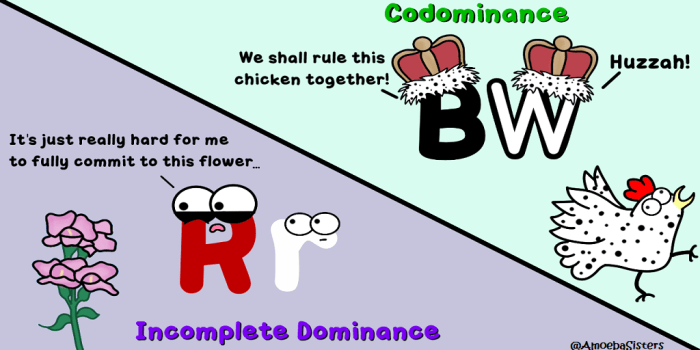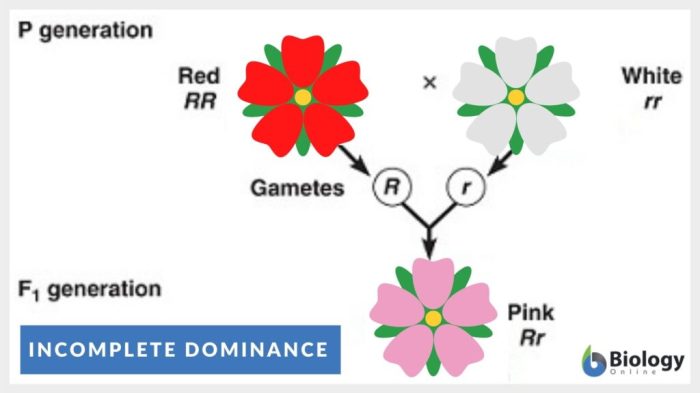Embark on an enlightening journey with the Amoeba Sisters Incomplete Dominance Worksheet Answer Key. Delve into the captivating realm of genetics, where the intricate interplay of alleles unveils the mysteries of inheritance and variation.
Incomplete dominance, a fascinating departure from the familiar Mendelian patterns, takes the spotlight. Witness how this genetic phenomenon challenges the dominance-recessive paradigm, revealing a symphony of intermediate phenotypes that paint the canvas of life with vibrant hues.
Amoeba Sisters Incomplete Dominance Worksheet Answer Key

Incomplete dominance occurs when neither allele in a heterozygous genotype is fully dominant over the other. Instead, the heterozygous genotype displays a phenotype that is intermediate between the phenotypes of the two homozygous genotypes.
For example, in snapdragons, the allele for red flowers (R) is incompletely dominant over the allele for white flowers (r). Heterozygous snapdragons (Rr) have pink flowers, which is an intermediate phenotype between red and white.
Worksheet Answer Key, Amoeba sisters incomplete dominance worksheet answer key
The worksheet answer key for incomplete dominance provides the genotypes and phenotypes of the individuals involved, as well as the Punnett squares used to determine the expected offspring ratios.
- Question 1:A red snapdragon (RR) is crossed with a white snapdragon (rr). What are the genotypes and phenotypes of the offspring?
- Answer:All offspring will be heterozygous (Rr) and have pink flowers.
- Punnett square:
| R | R | |
|---|---|---|
| r | Rr | Rr |
| r | Rr | Rr |
- Question 2:A pink snapdragon (Rr) is crossed with a white snapdragon (rr). What are the genotypes and phenotypes of the offspring?
- Answer:Half of the offspring will be heterozygous (Rr) and have pink flowers, and half will be homozygous recessive (rr) and have white flowers.
- Punnett square:
| R | r | |
|---|---|---|
| r | Rr | rr |
| r | Rr | rr |
Applications of Incomplete Dominance
Incomplete dominance is important for genetic diversity because it allows for a wider range of phenotypes within a population. This can be beneficial in environments where different phenotypes are advantageous in different conditions.
For example, in some species of moths, the color of the wings is determined by incomplete dominance. Light-colored moths are better camouflaged in light-colored environments, while dark-colored moths are better camouflaged in dark-colored environments. Incomplete dominance allows for a range of wing colors within a population, which can increase the survival of the species in different habitats.
Incomplete dominance can also be used in breeding programs to create new varieties of plants and animals with desired traits. For example, in cattle, the allele for red coat color is incompletely dominant over the allele for white coat color.
Breeders can cross red cattle with white cattle to produce roan cattle, which have a mixture of red and white hairs.
Commonly Asked Questions
What is incomplete dominance?
Incomplete dominance occurs when neither allele in a heterozygous genotype is fully dominant over the other, resulting in an intermediate phenotype.
How does incomplete dominance differ from complete dominance?
In complete dominance, one allele masks the expression of the other, leading to a dominant phenotype. In incomplete dominance, both alleles contribute to the phenotype.
What are some examples of incomplete dominance?
Examples include the Andalusian horse’s coat color (black and white hairs intermingling), the pink flowers of snapdragons (red and white alleles), and the ABO blood group system in humans.

